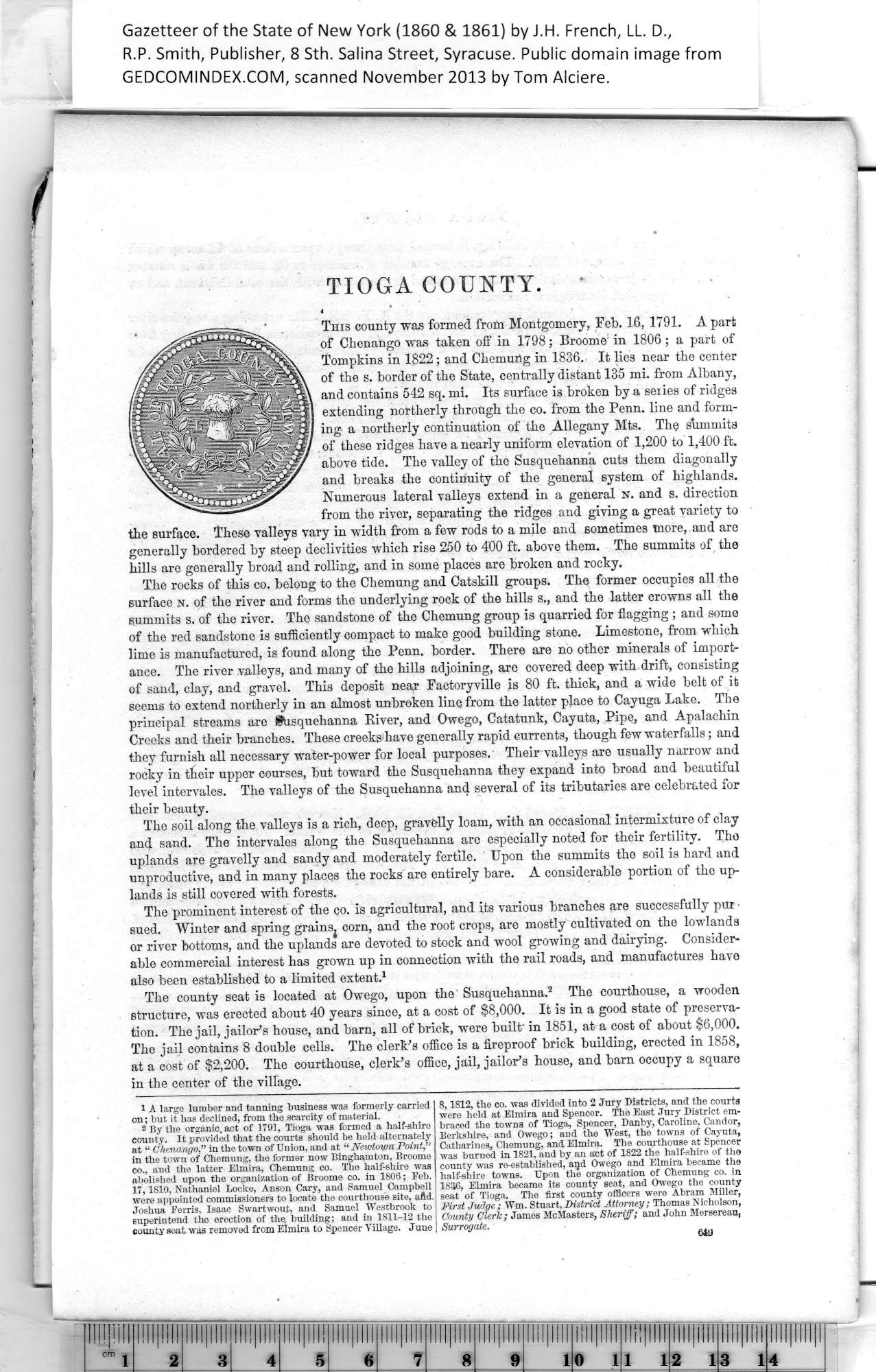|
TIOGA COUNTY.
This county was formed from Montgomery, Feb. 16, 1791. A part
of Chenango was taken oif in 1798; Broome1 in 1806; a part of
Tompkins in 1822; and Chemung in 1836. It lies near the center
of the s. border of the State, centrally distant 135 mi. from Albany,
and contains 542 sq. mi. Its surface is broken by a seiies of ridges
extending northerly through the co. from the Penn, line and form¬
ing a northerly continuation of the Allegany Mts. The summits
of these ridges have a nearly uniform elevation of 1,200 to 1,400 ft.
above tide. The valley of the Susquehanna cuts them diagonally
and breaks the continuity of the general system of highlands.
Numerous lateral valleys extend in a general n. and s. direction
from the river, separating the ridges and giving a great variety to
the surface. These valleys vary in width from a few rods to a mile and sometimes more, and are
generally bordered by steep declivities which rise 250 to 400 ft. above them. The summits of the
hills are generally broad and rolling, and in some places are broken and rocky.
The rocks of this co. belong to the Chemung and Catskiil groups. The former occupies all the
surface n. of the river and forms the underlying rock of the hills s., and the latter crowns all the
summits s. of the river. The sandstone of the Chemung group is quarried for flagging ; and some
of the red sandstone is sufficiently compact to make good building stone. Limestone, from which
lime is manufactured, is found along the Penn, border. There are no other minerals of import¬
ance. The river valleys, and many of the hills adjoining, are covered deep with drift, consisting
of sand, clay, and gravel. This deposit near Factoryville is 80 ft. thick, and a wide belt of it
seems to extend northerly in an almost unbroken line from the latter place to Cayuga Lake. The
principal streams are Susquehanna Biver, and Owego, Catatunk, Cayuta, Pipe, and Apalachin
Creeks and their branches. These creekshave generally rapid currents, though few waterfalls; and
they furnish all necessary water-power for local purposes. Their valleys are usually narrow and
rocky in their upper courses, but toward the Susquehanna they expand into broad and beautiful
level intervales. The valleys of the Susquehanna and several of its tributaries are celebrated for
their beauty.
The soil along the valleys is a rich, deep, gravelly loam, with an occasional intermixture of clay
and sand. The intervales along the Susquehanna are especially noted for their fertility. Tho
uplands are gravelly and sandy and moderately fertile. Upon the summits the soil is hard and
unproductive, and in many places the rocks are entirely bare. A considerable portion of the up¬
lands is still covered with forests.
The prominent interest of the co. is agricultural, and its various branches are successfully pur ■
sued. Winter and spring grains^ corn, and the root crops, are mostly cultivated on the lowlands
or river bottoms, and the uplands are devoted to stock and wool growing and dairying. Consider¬
able commercial interest has grown up in connection with the rail roads, and manufactures have
also been established to a limited extent.1
The county seat is located at Owego, upon the Susquehanna.2 The courthouse, a wooden
structure, was erected about 40 years since, at a cost of $8,000. It is in a good state of preserva¬
tion. The jail, jailor's house, and barn, all of brick, were built' in 1851, at a cost of about $6,000.
The jail contains 8 double cells. The clerk's office is a fireproof brick building, erected in 1858,
at a cost of $2,200. The courthouse, clerk's office, jail, jailor's house, and barn occupy a square
in the center of the village.
8,1812, the co. was divided into 2 Jury Districts, and the courts
were held at Elmira and Spencer. The East Jury District em¬
braced the towns of Tioga, Spencer, Danby, Caroline, Candor,
Berkshire, and Owego; and the West, the towns of Cayuta,
Catharines, Chemung, and Elmira. The courthouse at Spencer
was burned in 1821, and by an act of 1822 the half-shire of tho
county was re-established, and Owego and Elmira became the
half-shire towns. Upon the organization of Chemung co. in
1836, Elmira became its county seat, and Owego the county
seat of Tioga. The first county officers were Abram Miller,
First Judge.; Wm. Stuart, District Attorney; Thomas Nicholson,
County Cleric; James McMasters, Sheriff; and John Mersereau,
Surrogate.
1 A large lumber and tanning business was formerly carried
on; but it has declined, from the scarcity of material.
2 By the organic, act of 1791, Tioga was formed a half-shire
county. It provided that the courts should be held alternately
at “ Chenango,” in the town of Union, and at “ Newtown Point,”
in the town of Chemung, the former now Binghamton, Broome
co., and the latter Elmira, Chemung co. The half-shire was
abolished upon the organization of Broome co. in 1806; Feb.
17,1810, Nathaniel Locke, Anson Cary, and Samuel Campbell
were appointed commissioners to locate the courthouse site, afid.
Joshua Ferris, Isaac Swartwout, and Samuel Westbrook to
superintend the erection of the building; and in 1811-12 the
county seat was removed from Elmira to Spencer Village. June
m
|
